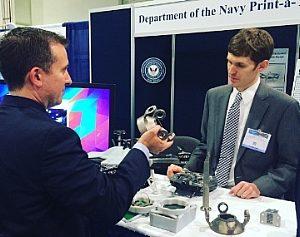 3D printing technology has various militaries across the world eagerly standing at attention, many of which are researching and aiding in future technological developments. The United States Navy has been especially fond of 3D printing technology, having utilized it for a number of applications over the last year or so. In 2015, the Navy 3D printed custom drones aboard the USS Essex, and also implemented Inovati’s unique Kinetic Metallization system into their component repair process. Back in March, the US Navy successfully launched a Trident II D5 missile that was equipped with a 3D printed component from Lockheed Martin, ultimately showcasing the readiness and reliability that 3D printing technology can provide.
3D printing technology has various militaries across the world eagerly standing at attention, many of which are researching and aiding in future technological developments. The United States Navy has been especially fond of 3D printing technology, having utilized it for a number of applications over the last year or so. In 2015, the Navy 3D printed custom drones aboard the USS Essex, and also implemented Inovati’s unique Kinetic Metallization system into their component repair process. Back in March, the US Navy successfully launched a Trident II D5 missile that was equipped with a 3D printed component from Lockheed Martin, ultimately showcasing the readiness and reliability that 3D printing technology can provide.
During the Department of the Navy Additive Manufacturing Showcase, which took place at the University of Mary Washington, Dahlgren campus on April 20, attendees were addressed by Dr. John Burrow, the deputy assistant secretary of the Navy for Research, Development, Test and Evaluation. Dr. Burrow and Navy officials continued to speak highly of 3D printing technology, and shared their vision of implementing on-demand 3D printing capabilities onto their vast array of Navy fleets and shore-based commands in the near future. The exhibition, which was attended by more than 100 visitors, was comprised of a handful of additive manufacturing-based projects conducted by different government officials, all of which were intended to directly benefit the Navy’s warfighter.
“Additive Manufacturing will fundamentally change how we think, how we do business, the cost variable, and how we make decisions,” said Dr. Burrow. “I think you are about to see its operational and technical potential literally explode off the map.”
As the Navy continues to integrate 3D printing technology into their supply strategy, command supply officers will soon be able to obtain specially ordered parts and equipment for rapid production. This would greatly improve the order time for parts from weeks or months to days or hours, and would also enhance logistics operations and promote cost reduction. There are a number of essential components that the Navy would greatly benefit from having manufactured on-demand and delivered on the spot, such as customized unmanned systems, avionics components, and even explosive device detectors.
One exhibition at the showcase that was used as an example by Dr. Burrow was the Globe Valve Training Aid, a one-inch manual primary globe valve that was printed by NSWC Dahlgren Division engineers from the Combat Direction Systems Activity in Dam Neck, Virginia. This mock-up valve is ideal for classroom training at the Norfolk Naval Ship Yard, helping to familiarize students with how these valves operate and are repaired. Before 3D printing technology was used for this exhibit, the valve-based training system cost about $50,000 to manufacture. In the exhibitors’ case, a total of $500 was spent to create the Globe Valve Training Aid with 3D printing technology, a considerably substantial difference in price.

Navy engineer Steve Price talks to an attendee about the small additively manufactured modular payload multi-rotor at the 2016 Sea-Air-Space Expo.
Dr. Burrow went on to highlight the various stages of development that additive manufacturing has helped the Navy with, from the earliest of conceptual prototypes to component and system testing. Still, the Navy has their work set out for them, and must solve critical issues before fully integrating on-demand 3D printing into their system, such as developing the correct specifications for components, ordering and billing, and intellectual property laws, just to name a few. According to Captain Armen Kurdian, Director of Engineering and Product Support for the Navy Supply Command, the Navy must develop new strategies to enhance their on-demand capabilities so that officers can simply put in a demand signal for a particular component and have it manufactured instantaneously.
“We will need to develop new contracting strategies to exploit on-demand or even automated IDIQ (indefinite order, indefinite quantity] so that a fleet user could put in a demand signal for a particular component,” said Kurdian. “An order would be transmitted through the supply system to the most suitable geographic location where it could conceivably get a 3-D machine printing that part without any human interaction from the moment the demand signal is sent.”
Aside from the 3D printed Global Valve Training Aid, a number of other projects showcased at the event proved the immense value of additive manufacturing technology, including MK29 Helmet Modifications and the Meso-scale Robotic Locomotion Initiative. A handful of these projects were then selected to be displayed at the 2016 Sea-Air-Space Expo, which took place from May 16-18. All in all, the Navy Additive Manufacturing Showcase was jam-packed with promising discussion and proof-of-concept exhibitions, and made quite the case for future revamping of their part and equipment production process with on-demand 3D printing. What are your thoughts on uses for 3D printing in the military? Discuss further over in the Navy Discusses 3D Printing Benefits forum at 3DPB.com.
Subscribe to Our Email Newsletter
Stay up-to-date on all the latest news from the 3D printing industry and receive information and offers from third party vendors.
Print Services
Upload your 3D Models and get them printed quickly and efficiently.
You May Also Like
Printing Money Episode 30: Q1 2025 Public 3D Printing Earnings Review with Troy Jensen, Cantor Fitzgerald
Printing Money is back with Episode 30, and it’s that quarterly time, so we are happy and thankful to welcome back Troy Jensen (Managing Director, Cantor Fitzgerald) to review the...
3DPOD 260: John Hart on VulcanForms, MIT, Desktop Metal and More
John Hart is a Professor at MIT; he´s also the director of the Laboratory for Manufacturing and Productivity as well as the director of the Center for Advanced Production Technologies....
Etsy Design Rule Change Reduces Selection of 3D Printed Goods
Online marketplace Etsy has implemented a rule change requiring all 3D printed goods on the site to be original designs. The update to the site’s Creativity Standards states, ¨Items produced using...
3DPOD 259: AM at Stratasys with Rich Garrity, Chief Business Unit Officer
Rich Garrity is the Chief Business Officer of Stratasys. Rich shares Stratasys´ vision and future with us. We talk about machines, applications, clients, and the market in general. What technologies...


































